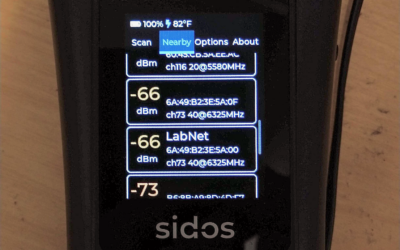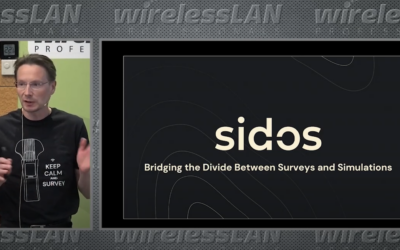Wi-Fi has continually evolved to meet the demands of our increasingly interconnected world, and Wi-Fi 6E is the latest iteration aimed at revolutionizing wireless connectivity. As an extension of Wi-Fi 6 into the 6 GHz band, Wi-Fi 6E transforms the Wi-Fi landscape with unprecedented bandwidth and less congested airwaves. In this blog post, we’ll delve into the breakthrough features of Wi-Fi 6 and 6E and how they’re paving the way for a more streamlined, power-efficient, and high-capacity Wi-Fi experience. We’ll also discuss Wi-Fi 6E’s unique advantage, as it extends these benefits into the newly unlocked 6 GHz band.
Expanded Spectrum Access and Flexibility
Wi-Fi 6E’s defining feature is its expanded spectrum access into the 6 GHz band, a significant leap from previous Wi-Fi standards. This expansion introduces up to 1,200 MHz of additional spectrum, paving the way for many new channels that help alleviate congestion and provide a much cleaner and less interfered radio environment.
In comparison, previous Wi-Fi generations, including Wi-Fi 5 and Wi-Fi 6, operate in the heavily congested 2.4 GHz and 5 GHz bands. With the increasing number of Wi-Fi devices, these bands have become crowded, leading to interference and performance issues.
However, Wi-Fi 6E, by operating in the 6 GHz band, significantly mitigates these issues. It offers seven additional 160 MHz channels or fourteen 80 MHz channels, which is especially beneficial for high-bandwidth applications like VR/AR, high-definition video streaming, and large file transfers.
Moreover, the 6 GHz band exclusively allows Wi-Fi 6E devices, meaning they can take full advantage of Wi-Fi 6 features such as OFDMA and MU-MIMO without legacy device interference. This contributes to higher data rates, lower latency, and overall improved network performance, marking Wi-Fi 6E as a true revolution in wireless communication.
Orthogonal Frequency Division Multiple Access (OFDMA)
Orthogonal Frequency Division Multiple Access (OFDMA) is a key feature introduced with Wi-Fi 6 and further developed in Wi-Fi 6E, contributing significantly to their advancements over previous Wi-Fi generations.
In the context of Wi-Fi, OFDMA enables more efficient use of available spectrum by dividing each wireless channel into smaller sub-channels, also known as resource units (RUs). Multiple devices can transmit and receive data simultaneously on different RUs within the same channel.
This simultaneous data transmission capability of OFDMA provides the following benefits in Wi-Fi 6E:
1. Improved Network Efficiency: By allowing several users to share a single channel, OFDMA optimizes network capacity. This is especially beneficial in crowded environments with many connected devices, such as schools, hospitals, sports venues, and various public venues.
2. Lower Latency: Since multiple devices can communicate concurrently, they don’t have to wait for their turn to transmit or receive data. This results in significantly lower network latency, improving the performance of latency-sensitive applications like online gaming or video calls.
3. Better Traffic Management: OFDMA allows for more granular control of network traffic. It’s able to allocate RUs based on the data requirements of each device, offering seamless experiences even in networks with a diverse mix of high-bandwidth and low-bandwidth devices.
4. Expanded Spectrum Access in 6 GHz Band: Wi-Fi 6E’s expansion into the 6 GHz band provides more available channels for OFDMA, reducing network congestion and further enhancing its benefits.
By implementing OFDMA, Wi-Fi 6E offers improved performance, lower latency, and more efficient use of available spectrum, making it better equipped to handle today’s diverse and demanding Wi-Fi needs.
Target Wake Time (TWT)
Target Wake Time (TWT) is a power-saving feature introduced with Wi-Fi 6 and maintained in Wi-Fi 6E, bringing substantial improvements compared to earlier Wi-Fi standards.
TWT allows devices to negotiate when and how often they will wake up to send or receive data, effectively scheduling communication with the network. This results in devices spending more time in a low-power sleep state, thereby saving battery life.
In contrast, previous Wi-Fi standards lacked this level of advanced power management. Devices were largely responsible for deciding when to wake up and check for available data, leading to increased power consumption and network congestion, particularly in environments with a high density of connected devices.
With TWT, Wi-Fi 6E devices can efficiently manage their power consumption based on their data requirements. For instance, low-power IoT devices that only need to transmit data intermittently can wake up less frequently, significantly extending their battery life.
Additionally, by scheduling transmissions, TWT also helps reduce network congestion. TWT ensures a smoother, more efficient network performance by minimizing the number of devices simultaneously attempting to communicate.
Therefore, incorporating TWT in Wi-Fi 6E improves power efficiency, is particularly beneficial for battery-powered devices, and contributes to a more stable and manageable network environment.
BSS (Basic Service Set) Coloring and Spatial Reuse
The traditional 802.11 Wi-Fi standard employs a method called carrier-sense multiple access with collision avoidance (CSMA/CA) to reduce the likelihood of multiple devices interfering with one another by transmitting simultaneously. However, this technology, based on static interference thresholds, often leads to unnecessary deferral of transmissions, especially with an increased number of Wi-Fi devices.
For instance, if two devices, each associated with a different BSS, can receive each other’s transmissions, they would defer their own transmission whenever they detect the other. However, simultaneous transmission by both devices may not necessarily cause significant interference to disrupt the reception at the receivers’ end.
In the past, devices needed to inspect the MAC header, determining whether a received packet belonged to their own BSS. This process consumed power that could be saved if devices could quickly identify the BSS by looking at the PHY header alone and subsequently disregarding packets from a different BSS. Unfortunately, such a provision did not exist prior to Wi-Fi 6.
The 802.11ax (Wi-Fi 6) standard addresses these issues through the new BSS Coloring and Spatial Reuse mechanisms. BSS Coloring allows devices operating in the same frequency space to rapidly differentiate between packets from their own BSS and those from an Overlapping BSS (OBSS) simply by checking the BSS color value in the HE PHY header. Simultaneously, in certain scenarios, Spatial Reuse enables devices to transmit concurrently with OBSS packets they receive, as opposed to deferring transmissions due to legacy interference thresholds.
The Wi-Fi 6E, maintaining these features, further enhances network performance. As every Wi-Fi 6 and Wi-Fi 6E device understands BSS color, it not only allows for earlier packet drop, resulting in power savings, but also identifies spatial reuse opportunities, contributing to improved network efficiency.
MU-MIMO (Multi-User Multiple-Input Multiple-Output)
Multi-User Multiple-Input Multiple-Output (MU-MIMO) is a feature first introduced in Wi-Fi 5 and significantly enhanced in Wi-Fi 6 and Wi-Fi 6E. MU-MIMO allows for the simultaneous transmission of data to multiple devices, marking a substantial leap from earlier Wi-Fi standards.
In earlier Wi-Fi generations, the router could only communicate with one device at a time, serving other devices in a sequential manner. This led to less efficient use of the network and potential bottlenecks, particularly in environments with many connected devices.
However, MU-MIMO changed this by enabling an access point to transmit data to multiple devices concurrently. In Wi-Fi 5, this was limited to four devices and was only possible in downlink (from access point to client devices) communication.
Wi-Fi 6 and Wi-Fi 6E further enhance MU-MIMO functionality by supporting up to eight devices and extending it to uplink (from client devices to access point) communication. This means more devices can send and receive data simultaneously, reducing network latency and improving overall efficiency.
Moreover, Wi-Fi 6E’s expanded operation into the 6 GHz band offers more channels for MU-MIMO operation, further alleviating network congestion and delivering smoother, faster connections. This makes Wi-Fi 6E, with its advanced MU-MIMO capabilities, better equipped to handle today’s Wi-Fi needs, from dense device environments to high-demand data applications.
1024-QAM (Quadrature Amplitude Modulation)
1024-QAM, or Quadrature Amplitude Modulation, is a modulation scheme introduced in Wi-Fi 6 and further implemented in Wi-Fi 6E, which offers significant improvements over the earlier Wi-Fi standards.
Modulation schemes like QAM are used in wireless communication to convey data by changing some aspects of a carrier signal – its phase, frequency, or amplitude. In the context of QAM, both phase and amplitude are altered to encode data.
In previous Wi-Fi generations, up to 256-QAM was used, meaning the carrier signal was altered in 256 ways to represent data. However, Wi-Fi 6 and 6E use 1024-QAM, increasing the number of signal variations to 1024. This allows each signal to carry more data, leading to a 25% increase in throughput under ideal conditions compared to 256-QAM used in Wi-Fi 5.
The jump to 1024-QAM from 256-QAM means that more information can be transmitted simultaneously, increasing data transfer speed. This is particularly advantageous for high-bandwidth applications such as high-definition video streaming and online gaming.
However, it’s important to note that factors like distance and interference can impact the effectiveness of 1024-QAM, as it requires a high-quality signal to function optimally. This makes it more beneficial when the devices are close to the router or access point.
By incorporating 1024-QAM, Wi-Fi 6 and 6E provide increased data rates, allowing faster and more efficient communication between devices and networks.
Final Thoughts
Wi-Fi 6 and Wi-Fi 6E represent significant leaps forward in wireless technology. These standards introduce powerful features like OFDMA, TWT, and MU-MIMO, improving network efficiency, power management, and multi-device support.
Wi-Fi 6E, in particular, extends these benefits by leveraging the newly available 6 GHz band. This extra spectrum provides a less congested environment for high-bandwidth applications. At the same time, the exclusive presence of Wi-Fi 6E devices in this band ensures more efficient usage of these advanced features without legacy device interference.
It’s crucial to note that the full benefits of Wi-Fi 6E will require a new generation of access points and client devices capable of operating in the 6 GHz band. As Wi-Fi professionals, staying updated with these advancements is paramount to designing, analyzing, and optimizing networks for this exciting new frontier in wireless connectivity.
Stay tuned as we continue to explore the evolving landscape of Wi-Fi technology. Our following articles will delve into the implications of Wi-Fi 6E for network design, the challenges and opportunities it brings, and how you can prepare for this transformative shift in wireless networking.




